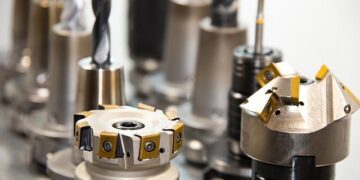$begingroup$
Because linear increases in delta-v require exponential increases in mass, small changes to the assumptions you make about fuel tank structural mass and engine thrust-to-weight ratio start to make very large changes in the final size of the rocket.
For example, if you’re getting off a 3.6g planet with a 7-stage rocket, the difference between 88% fuel fraction and 92% fuel fraction yields about a 10:1 difference in the total mass of the rocket.
So I don’t think it’s really reasonable to talk about ultimate theoretical limits; too many engineering factors are involved.
Locking down a lot of variables, I can tell you what kind of rocket you’d need for a given surface g, though. Let’s make these assumptions:
We are placing 1 ton of payload into low planetary orbit.
Required delta-v to reach orbit, including atmospheric and gravity losses, is 10,000m/s per surface g. Seems to hold for Earth, Mars, and the “Earthtoo” which was discussed in another Q/A.
We can build rocket stages of arbitrary size, with a tankage propellant fraction of 90%; the rocket stage mass is the tank mass plus the engine mass — ullage rockets, interstage, etc. is all handwaved out.
We have an infinite supply of Apollo-era rocket engines: RL-10, J-2, M-1, H-1, and F-1.
First-stage TWR at ignition must be at least 1.2 (relative to local gravity)
Middle-stage TWR at ignition must be at least 0.8
Final-stage TWR at ignition must be at least 0.5
Given those assumptions, here is a table of surface gravity, stage count, first-stage engines, and total rocket mass.
Surface First Total Saturn V
Gravity Stages Stage Mass, t Equivalent
0.5 2 1x RL-10 4.5
1.0 3 1x H-1 49.4 0.02
1.5 3 1x F-1 249.2 0.1
2.0 4 5x F-1 1329.0 0.5
2.5 5 40x F-1 8500.9 3
3.0 6 274x F-1 50722.2 17
3.5 7 2069x F-1 331430.9 100
4.0 8 20422x F-1 2836598.4 950
4.5 8 392098x F-1 47 million 15000
5.0 9 3.5 million F-1 391 million 130000
6.0 11 400 million F-1 38 billion millions
10.0 18 2.88e19 F-1 1.65e21 quadrillions
Up above 10g, something really interesting happens that is kind of a theoretical limit. The mass of the rocket reaches a measurable fraction of the mass of the entire planet it’s launching from.
At 10.3g, rocket mass is 0.035 of the mass of the planet.
10.4g, rocket mass is one fifth of the mass of the planet. This doesn’t actually alter the ∆v requirement — we’re going into orbit around the rocket/planet barycenter!
At 10.47g, the rocket is the planet, and we’re… just… chewing it up entirely, pulverizing it in a dust cloud expanding at 4km/s.
These extreme conclusions appear to be corroborated by this independently derived paper, which explores some other related aspects of super-Earth-based chemical rockets.
Another consideration recently brought up by user @uhoh is that as the linear scale of a given rocket stage increases, its mass, and thus the required thrust force to lift it, goes up by the cube of the scale, but the area available at the base of the rocket to mount engines goes up only by the square of the scale; this problem is made even worse here by the increasing surface gravity. The Saturn V was just about at the point where this relation starts to become problematic; the outboard engines on its first stage are mounted at the very edge of the stage in order to make room for their nozzles to gimbal.
Solid rockets don’t have the same dimensional constraints, and have very good thrust-to-weight and thrust-to-cost ratios, so they’re probably more likely to be used in lower stages for these very large rockets.
Stages much larger than the Saturn V first stage would need to address this with some combination of being shorter and squatter, or compromising engine gimbal range, or mounting engines in pods surrounding the tankage, and there might be fairly hard engineering limits at some point for those reasons. At the 3g mark, for example, the 274 first-stage engines would require a stage about 90 meters in diameter and 9 meters tall, at which point the engineering inefficiencies associated with the fuel tank proportions will be becoming serious.
![]()
StayOnTarget
1,12111 gold badge77 silver badges1717 bronze badges
answered Jul 30, 2016 at 20:53
Russell BorogoveRussell Borogove
168k1313 gold badges591591 silver badges697697 bronze badges
$endgroup$
17
$begingroup$
First, let us look at the rocket equation:
$$Delta v=ln left(frac{m_0}{m_f}right)v_e$$
That tells how much a rocket can change its velocity (the $Delta v$). The requirements for reaching a higher velocity for a minimal orbit would increase on your heavier Earth. (For constant density it is proportional to the radius.)
How can we increase the $Delta v$ of the rocket to keep up? We can increase the exhaust velocity, $v_e$, of the engine, but that cut-off is around 5000 m/s for chemical engines. The other thing we could do is increasing the mass ratio of the rocket $left(frac{m_0}{m_f}right)$. That is problematic too, as we can not really make the fuel tanks out of soap bubbles. Staging is the option left, you could place a big rocket under a small rocket to get a little more change in velocity. Then you are getting a linear benefit for an exponential expense.
As an example, the Saturn V rocket got into LEO (~9000 m/s), sent a payload towards the Moon (3120 m/s), the service module slowed the stack into LMO (820 m/s), and finally the LM landed and took off again (2*1720 m/s). There are still some unused fuel left in the service module then, so let us just call the total $Delta v$ of the Saturn V/Apollo 17 km/s. That is less than the requirements for a 2x radius Earth. The Apollo program was pretty expensive [citation needed], so it may take a while before a nation of a 2x Earth world attempts to go into orbit. The limit is, as you state, the ridiculously low payload ratio.
Another consideration is the increased surface gravity. (That scales linearly with diameter at constant density). That requires the rocket to have a higher thrust to weight ratio, and that will increase the dry mass, reducing the possible $Delta v$. (It also increases gravity losses, but that is mostly compensated by the lower scale height of the planet, reducing drag losses).
Eventually, the gravity is so high that even the most powerful engine can not lift itself from the ground. That at least is a definitive limit.
A more theoretical consideration, is $Delta v$ requirements actually a finite limit?
Surprisingly, it is not. Remember what I said about staging earlier: “you are getting a linear benefit for an exponential expense”. But there is not limit to what we can expend! Consider the following scenario: We add more and more stages at the bottom of the rocket, each of them has the same mass as all the stages on top of it. Then burning each of them gives the same mass ratio between before and after, therefore each of them are supplying
the same amount of $Delta v$. To add 10 times that amount, you need 10 stages each doubling the mass. To add 100 times that amount, you need to double a hundred times. The mass grows ridiculously fast, even doubling 10 times are over a thousand times more. But why should we stop 🙂
But can we really continue to add exponentially larger stages for ever?
After a while, other problems show up. For instance: Rockets are long and thin, to minimize drag. That shape can not be kept for very large rockets. The reason not is the square cube law. Conserving the same dimensional proportions, a rocket twice the height has 8 times more mass. But the base area of the rocket has only increased 4 times. That means that each unit of area has to support more mass. Sooner or later, even the strongest materials must give up, and you must give up the traditional rocket shape in favour of a wider base. That adds a lot to the drag! Problems like that are going to continue to show up:
“More mass means more problems, exponentially more mass means exponentially more problems.”
Summarized:
A modern design, larger rocket than the Saturn V, with modifications to increase the T/W ratio could probably make it to orbit on a 2x radius, 8x mass Earth. That is a feasibility limit, rockets that are ridiculously much larger may have a few km/s extra $Delta v$, but that does not alter the numbers a lot. In theory though, rockets can grow until the drag stops them, or the engines can no longer lift even themselves.
Or perhaps you at some point want to use the available resources of the planet to launch a single rocket to orbit.
![]()
answered Mar 9, 2016 at 8:48
![]()
$endgroup$
7
$begingroup$
note: I’ve accepted an answer 2.5 years ago. This paper was published recently so I thought I would add this supplemental answer since it may be an interesting reference for future readers.
The Space.com article No Way Out? Aliens on ‘Super-Earth’ Planets May Be Trapped by Gravity links to Michael Hippke’s ArXiv preprint Spaceflight from Super-Earths is difficult.
While the calculation is based on escape velocity rather than LSEO (Low Super-Earth Orbit) the conclusion is similar, the problem is exponential and it gets really difficult quickly.
The author uses the example of the planet Keppler-20b (see also here), and although there is some uncertainty, the planet’s size is roughly 1.9 that of earth, and it’s mass is almost 10 times that of Earth.
For a mass ratio of 83, the minimum rocket (1 t to $v_{esc}$) would carry 9,000 t of fuel on Kepler-20b, which is 3× larger than a Saturn V (which lifted 45 t). To
lift a more useful payload of 6.2 t as required for the James Webb Space Telescope on Kepler-20 b, the fuel mass would increase to 55,000 t, about the mass of the largest ocean battleships. For a classical Apollo moon mission (45 t), the rocket would need to be considerably larger, ∼ 400,000 t. This is of order the mass of the Pyramid of Cheops, and is probably a realistic limit for chemical rockets regarding cost constraints. (emphasis added)
answered Apr 24, 2018 at 3:56
![]()
uhohuhoh
148k5151 gold badges471471 silver badges14631463 bronze badges
$endgroup$
4
$begingroup$
Not a planetological exposition in sight so, I’ll add my two cents to this rather theoretical discussion.
Amongst exoplanetologists, the consensus has emerged that 1.6 Earth radii and 5 Earth masses is likely to be the upper limit to rocky planets. Simulations have shown that above these figures, the bodies develop increasingly Mini-Neptune like characteristics. This means very thick Helium Hydrogen atmospheres and crushing surface pressure.
Also since Michael Hippke’s slightly whimsical paper was referenced in one of the answers it seems appropriate to mention Ocean worlds at Super Earth masses. Ocean worlds present a host of habitability hurdles including a paucity of certain life critical elements like phosphorus, lack of volcanism, no water rock interface due to high pressure ice on the marine floor and others. These conditions will likely limit or even prevent the establishment of the vibrant prebiotic chemical environments that are necessary for biogenesis.
If the first assumption holds true, the highest gravity on a potentially habitable world will not exceed approximately 2.5g.(edit: and thus making it not quite so difficult to reach orbit with chemical rockets as would have been the case with a higher g value)
Suma
23722 silver badges1313 bronze badges
answered Feb 16, 2020 at 3:20
$endgroup$
7
$begingroup$
Great answers have been given, but one of the major themes is they assume a fixed wet to dry mass ratio of 10:1 (ish). The justification is:
You need to fix this as: there are no meaningful answers with without a value and, which value is subject to engineering nuances, which are difficult to handle.
10:1 is a good pick. (We can’t do much better than this and still have everything work so it seems sensible to stick at this)
The problem is that’s the limit of what we can make work on earth. A lot of the dry mass of a rocket is either:
directly related to the thrust-to-mass ratio (i.e. number/size of engines)
indirectly related to TMR (i.e. supports the structural loads)
Note, to keep gravity loses equivalent in practice the accelerations needed, hence TMR, is linear with the surface gravity. Hence so is a part of the the wet/dry mass ratio.
Once we take that into consideration things look a lot bleaker for the high g super-earths getting something into orbit using chemical rockets.
The actual numbers here are a little difficult to know, but if 5g world leads to a rocket with a w/d mass ratio of 5 to 1 (which I think is about right but…), you’re staring down the barrel of a $10^{20}$t type figure for launch mass. To put that into perspective, the ‘moon rocket’ is no longer a good comparison. That’s the mass of the moon it got to.
Theoretical limit? I’d say so.
At that mass things start taking a turn for the ‘XKCD’. Forget the practical issues they’re clearly long gone at “moon-sized-anything”. We hit cold hard theoretical limits.
You start having to deal with your own gravity.
Firstly those practical issues are big ones even if we laugh a little ‘engineering’ problems (like money, and where we might find $10^{19}$t of aerospace grade materials). For example that’s the sort of size that when you’re made out something solid and are already floating in space under 0G, you deforming under you own gravity into a ball. Trying to make that out of mostly liquid fuel and subject it to 5-10g…, you’re not staying the shape you started. Doesn’t matter what mass-ratio ‘hit’ you are willing to take. But we’ve got this far, we aren’t going to let a lack of unobtainium stop us.
No the real hard limit is how being so heavy effects your exhaust velocity. At the risk of getting too meta here if you’re heavy enough, its difficult to get things to come apart from you. It applies to planet sized rockets as much as it does planets.
If you’re a few million kilos, your ‘exhaust velocity’ is the velocity you can get your propellant to get to. If you have more mass than the moon, your propellant will have lost a lot of momentum by the time it’s left your gravitational influence. And this is the fate our rocket meets.
LOX/H2 has an exhaust velocity of about $4,400ms^{-1}$, about as good as we can do. Let’s just say our moon-sized rocket has the density of the moon too, and so has a similar escape velocity of $2,380ms^{-1}$. Then the useful exhaust velocity of our rocket (initial less escape) is less than half. hence half the delta-v. You won’t be going to space to day.
“Ok”, I hear you say, “that just mean’s you can’t go to space in that rocket.”, “How about a bigger one?”. Well “No”. This is another one of those “Even if everything sort of worked as before, you want go twice as fast, which is going to be a lot more mass.” type problems. Except now we really can’t just take the “make in 10 orders of magnitude bigger” approach. Apart from the fact that our rocket is now lot bigger than the planet which means we couldn’t possibly construct it, now we have no chance of using chemical rockets to propel us anywhere.
To gain any momentum we need to chuck something out of our gravity well, and the exhaust velocity of chemical rockets don’t make when we are this big.
We are now truly stuck.
But wait: directly the exhaust doesn’t make it out, but I wonder if you could try different way of getting mass out of a very deep gravity well. Shouldn’t be too hard. Even if it was only a little bit, we could always just scale it up…
answered Feb 1, 2019 at 17:00
drjpizzledrjpizzle
34911 silver badge55 bronze badges
$endgroup$
4
$begingroup$
On a practical engineering side of things. Ultimately you are limited by exhaust velocity. In theory you can always just make a bigger engine, bigger tanks, etc. Ridiculously expensive, but possible. This would seem to set the real limit to material strength. Material strength is likely to give out before the gravity wells pull exceeds the exhaust velocity of even moderately modern fuels.
For example, LF+LOX typically has an exhaust velocity of around 4,400 m/s. Which will fight up to 448 G of gravity. Literally more than the sun. Practically however much less than that. So size of the planet itself presents no real deal killers, it just makes the payloads mass fraction very VERY low.
At some point though other technologies, like nuclear bomb drives (https://en.wikipedia.org/wiki/Project_Orion_(nuclear_propulsion)), become the only feasible affordable way off the planet.
answered Jan 1, 2019 at 18:00
$endgroup$
2
>>> Read full article>>>
Copyright for syndicated content belongs to the linked Source : Hacker News – https://space.stackexchange.com/questions/14383/how-much-bigger-could-earth-be-before-rockets-wouldnt-work































